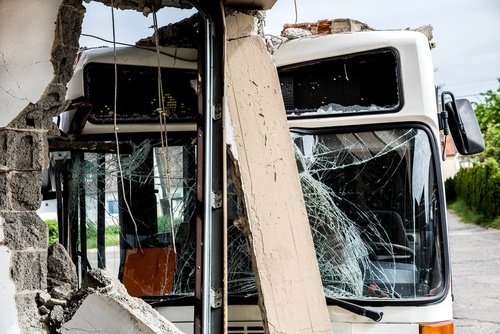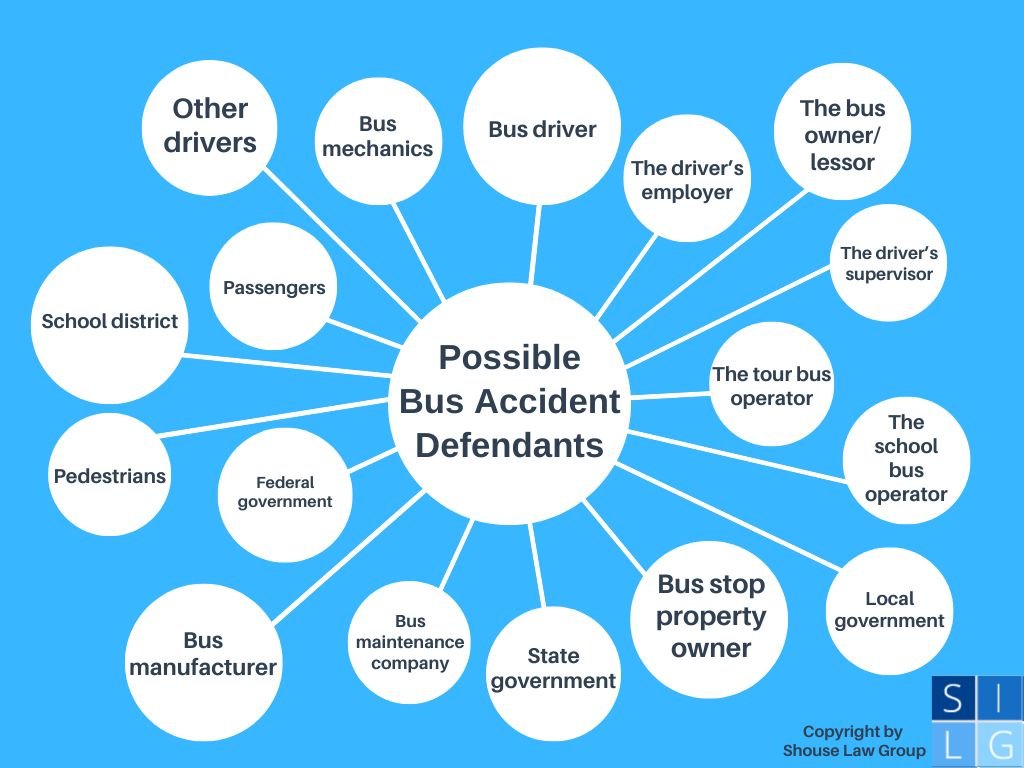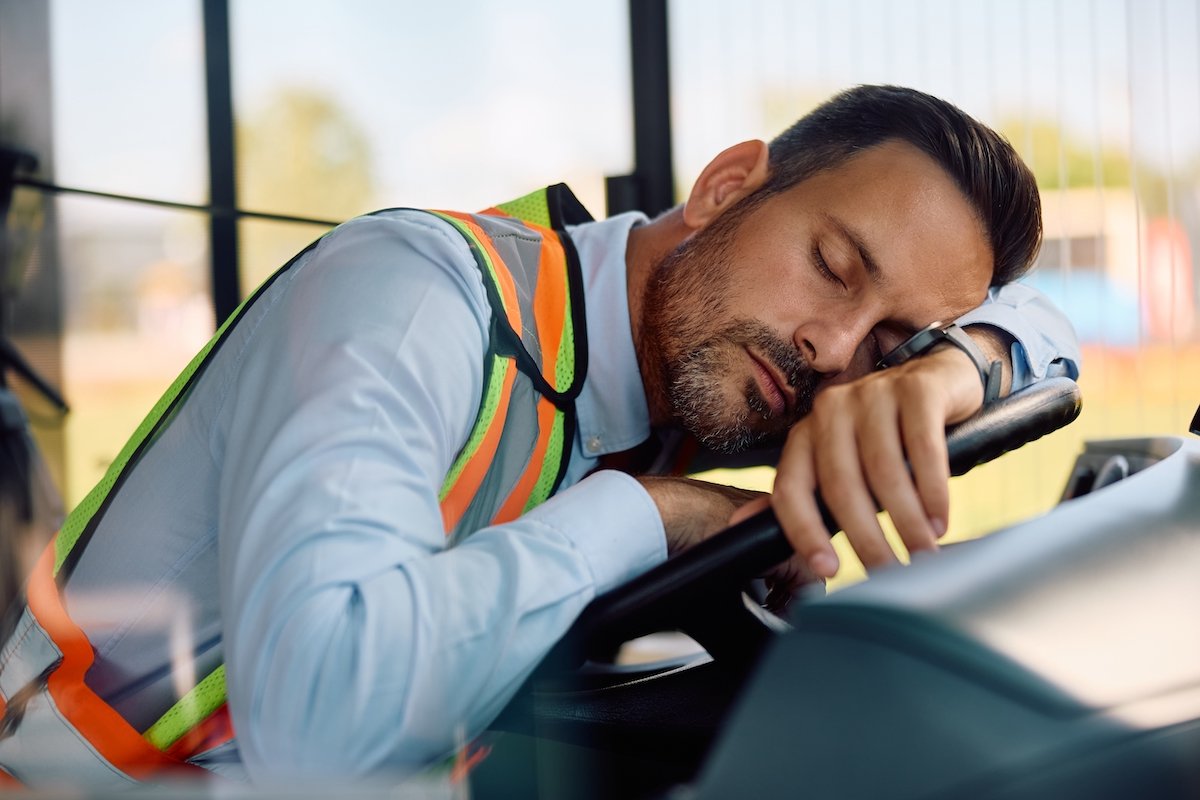When you are injured in a bus accident, you may be left with expensive medical bills, lost wages, and pain and suffering. A personal injury lawsuit allows you and your family to seek compensation for your injuries.
Bus accidents are often caused by the driver’s negligence, though drivers are usually judgment-proof. It makes much more sense to sue the bus company, which is vicariously liable for its employees’ negligence and has much deeper pockets.
Depending on the case, you may also have grounds to sue the bus manufacturer for defective parts. The local government may even be liable for contributing to the accident by unmaintained roads or bad signage.
Below, our California bus injury lawyers discuss the following topics:
- 1. Common Carriers
- 2. Who is liable?
- 3. School Bus Laws
- 4. What compensation can I get?
- 5. Common Injuries
- 6. What if my child or spouse was killed?
- 7. Statute of Limitations
- Additional Resources
If you have further questions about bus accidents after reading this article, please contact us at Shouse Law Group.

Under Vehicle Code 22406, bus drivers in California may not drive faster than 55 miles per hour.
1. Common Carriers
Buses are considered “common carriers” because they transport passengers for a fee. As such, bus drivers and their employers have a higher standard of care than ordinary drivers. As California Civil Code 2100 says,
“A carrier of persons for reward must use the utmost care and diligence for their safe carriage, must provide everything necessary for that purpose, and must exercise to that end a reasonable degree of skill.”
Therefore if a bus company fails to:
- make necessary repairs,
- inspect and maintain their vehicles,
- hire qualified drivers,
- train and supervise drivers, or
- require its drivers to take sufficient rest periods,
the company may be violating its duty of care as a common carrier. If this violation results in an accident where you get injured, then you have grounds to sue for negligence.1
2. Who is liable?
Depending on the circumstances of your bus accident, you may have grounds to sue any of the following parties depicted in this bubble graph:

Under California’s “comparative fault” law, you can recover damages even if you share some level of fault in causing the crash. However, the your damages would then be reduced based on your share of fault.2
3. School Bus Laws
California law prohibits passing stopped school buses if its red lights are flashing. On two-lane roads, even drivers going the opposite direction must stop until the red lights cease flashing.3
At this time, seat belts are not required on school buses manufactured prior to July 1 2004 or 2005 (depending on the type of bus). In fact, seat belts will not be universally mandated in the state until July 1, 2035!4
This means children passengers in old school buses face much more serious injuries in the event of a crash. Even still, school buses are statistically safer for children than getting a ride to school in a car.5
4. What compensation can I get?
Following a bus accident, you may be eligible for compensatory damages to cover your:
- Medical bills,
- Lost income,
- Future lost earnings,
- Vehicle repair,
- Loss of consortium, and
- Pain and suffering.
If the defendant acted with fraud or malice, you may also be able to claim punitive damages. These can be much higher than compensatory damages.
5. Common Injuries
Common bus accident injuries can be more complicated than typical car crash injuries. Passengers can be thrown and could hit other seats, passengers, bars, windows, or the floor. Typical injuries we see include:
- Head trauma
- Neck injuries
- Back injuries
- Broken bones
- Internal injuries
- Burns
- Crushing injuries
- Paralysis
- Loss of a limb

Under Vehicle Code 21702, bus drivers in California cannot drive more than 10 hours straight in one day (or 10 hours in a 15-hour time span) without then taking an eight-hour rest period.
6. What if my child or spouse was killed?
When a spouse or child is killed in a car accident, surviving “next of kin” may file a wrongful death lawsuit against the responsible parties.6
Damages you can recover in a wrongful death claim include:
- Funeral costs;
- Burial expenses;
- Financial losses to the family from lost income and lost future earnings; and
- Loss of companionship, emotional support, affection, guidance, love, and sexual relations.
7. Statute of Limitations
Following a bus accident, you typically have a two-year statute of limitations to bring a lawsuit against the liable parties. After two years, you would be barred from filing suit.
Note that the statute of limitations pauses (“tolls”) for child victims until they turn 18 years old. So for example if a 14-year-old gets hit by a tour bus, they would have until their 20th birthday to sue (18 years old plus the two-year statute of limitations).
However, claims against the government carry only a six-month statute of limitations. So if your accident was caused by a public bus or by badly maintained municipal roads, this six-month deadline would apply to you.7
In any case, it is a good idea to contact a personal injury attorney as soon as possible after your accident to start working on your case. If you do not, then:
- memories may fade,
- evidence may disappear, and
- it will be harder to prove that your injuries stemmed from the bus accident.
Additional Resources
For more information, refer to the following:
- Safety Matters: The “So What” Behind Bus Safety Records – Info sheet by the Federal Motor Carrier Safety Administration (FMCSA).
- Passenger Carrier Safety Information – Regulatory information by the FMCSA.
- Large Truck and Bus Crash Facts – Statistics by FMCSA.
- School Bus Safety – Video by National Highway Traffic Safety Administration (NHTSA).
- Evaluating Bus Accident Risks in Public Transport – Scholarly article in Transportation Research Procedia.
Legal References:
- See also California Civil Code 1714. California Civil Code 2100. California Civil Jury Instructions (CACI) 426. Note that Vehicle 21702 makes it a misdemeanor in California for a bus driver to be behind the wheel for too many hours in a day. A drowsy bus driver who drives in excess of the Vehicle Code 21702 limit and causes an accident may be liable under California’s negligence per se laws.
- Perez v. Van Groningen & Sons, Inc. (1986) 41 Cal.3d 962, 967 (“Under the doctrine of respondeat superior, an employer is vicariously liable for his employee’s torts committed within the scope of the employment.” California Civil Jury Instructions (CACI) 405. California Civil Jury Instructions (CACI) 406. California Civil Jury Instructions (CACI) 400. See also Mary M. v. City of Los Angeles (1991) 54 Cal.3d 202. See also Bailey v. Filco, Inc. (1996) 48 Cal.App.4th 1552.
- VC 22454.
- VC 27316. AB 1798 (2018).
- National Highway Traffic Safety Association (NHTSA) — School Bus Safety. (“Students are about 70 times more likely to get to school safely when taking a school bus instead of traveling by car.”)
- California Code of Civil Procedure 377.60.
- California Code of Civil Procedure §335.1. California Government Code 945. California Government Code 815.2. State governments generally have a claim of “sovereign immunity” from many types of lawsuits. However, California has waived sovereign immunity in certain cases of employee negligence. When a negligent public bus driver causes an accident, you can file a claim against the state or local government that operates the bus line.
